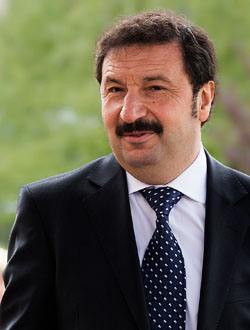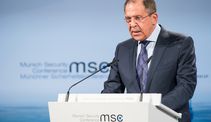Moscow’s Shocks and Options

 GB examines Russia’s concurrent crises and possible exits with one of its leading economic thinkers
GB examines Russia’s concurrent crises and possible exits with one of its leading economic thinkers
GB: What are the causes of the current economic crisis in Russia?
VM: Russia is facing a unique combination of structural, cyclical and external shocks. I would say that there are several causes of the current crisis. First of all, Russia is affected by the structural crisis that has hit the advanced economies of Europe. Second, there is a business cycle issue for Russia’s economy. There is a downturn in terms of the investment cycle of some of the biggest state-controlled corporations. Third, there are external shocks – on the one hand plummeting oil prices, and on the other hand international sanctions, which have cut some enterprises off from the financial markets of advanced economies.
I would also note that Russia has an increasing birth rate but a diminishing working population. Last year, therefore, we had the phenomenon of a diminishing growth rate with diminishing national unemployment. Put together, as mentioned, Russia has been hit by a combination of structural, cyclical and external shocks. Countries can usually cope with one type of shock, but what’s to be done with all of these shocks concurrently? Such a combination can be difficult because you have to use not only different but indeed opposite or contradictory instruments to deal with individual crises. For instance, for the cyclical crisis, you have to enact countercyclical policy, such as budgetary or fiscal stimulus and something like quantitative easing or monetary stimulus. For the external shock, however, the traditional recommendation is the opposite of stimulus: you have to consolidate the budget and keep the macroeconomic fundamentals as conservative as possible. So different economic diseases have different remedies.
In my view, the structural problem is Russia’s most important challenge – more important than even the sanctions or the steep fall in the price of oil. The structural problem consists in the fact that, over the last 10 years, Russia failed to launch profound, sustained institutional reforms. Everyone recognizes the crying need for such reforms, but when you have a lot of money – in Russia’s case, oil money before the crisis – the incentives for such reform are not compelling. The result is institutional decay that is not atypical for many economies based on resource rents.
GB: What are the manifestations of the crisis today? What is different today in Russia than a year ago or five years ago?
VM: Five years ago was 2008-2009 – that is, the beginning of the global crisis – and so Russia’s economy contracted significantly that year, as with the global economy. However, with the exception of 2009, Russian growth rates from 2000 to 2012 were above global averages. From 2013, the average growth of Russia has been lower than that of many advanced economies. Of course, this is quite painful. It is a very important indicator that the national growth model should be debated and changed.
GB: What can be done on the structural side?
VM: In broad economic terms, to put it succinctly, there should be a shift from a demand-side economy to a supply-side economy: radical improvement of the investment climate, moderation of taxes, more robust contract law, and so on. This is the opposite of increasing demand through budget spending. This is, to some extent, what Margaret Thatcher did in the early 1980s in the UK. For the last 15 years, the Russian economy grew mostly based on increasing demand from households and companies. It is clear that for sustainable economic growth you need to do much more for the business environment – to stimulate demand through instruments such as taxes and monetary policy, and through institutions like the court system, competition policy, and so on.
But when your economy is based on a flood of rent money, you do not need institutions. This is a not uncommon dynamic in history. I would urge GB readers to consider the Spanish empire in the 16th century, which started that century as one of the world’s biggest and most international economies, and entered the 17th century as one of the poorest countries in Europe because of the flood of silver and gold from the Americas. The Soviet Union collapsed to a large extent because its economy was adjusted to high oil prices; so when oil prices fell institutions were destroyed. Bref: windfall money destroys institutions and growth – this is something of a general rule. Excess money leads to the decay of institutions, or the failure to bring about reforms. And so Russia, at the start of this new century, needs reform of its non-economic institutions – the court system, law enforcement, property rights, and other institutions.
GB: What can be done on the shock side, and is the shock-side remedy more long term than the structural remedy?
VM: Institutional reforms are strongly needed in any event – for both the structural problem and the external shocks. The good news is that the Russian economy currently has several advantages, even in the face of today’s economic crisis: very low sovereign debt (about 12 percent of GDP) and very low external sovereign debt (about 2 percent of GDP). There is almost no budget deficit. Unemployment is very low. International reserves are high; to be sure, they have diminished over the last year, but they remain quite high because the central bank shifted to inflation targeting and effectively stopped wasting reserves. All of this is important in order to withstand external shocks, and in a very cheap way. It would be very dangerous to repeat the experience of the Soviet Union, which also faced a double shock in the mid-1980s – a budgetary shock due to a decrease in the price of oil, and an anti-alcohol campaign that destroyed the second important pillar of the Soviet budget: excises on alcohol. The Soviet Union mistakenly started to increase both its debt and its budget deficit: the economy accelerated for two years and then collapsed. So it is important to balance the economy properly and carefully. What is key, in the short run, is the budget policy – that is, to find efficiencies, and also budget planning in order to shift to expenditures with high multipliers, including social and transport infrastructure. Of course, export stimulus is also very important. Sometimes you can entertain import substitution ideas, as we have been doing. But import substitution without the stimulation of non-raw material exports is not a very efficient policy for the time being in Russia. So we need a special policy to support exports and a policy to stimulate competition, because the current situation with the low and unstable exchange rate is the biggest barrier to the competitiveness of Russia – far worse than the sanctions-cum-counter-sanctions dynamic, even if this dynamic also has an impact on the ruble.
GB: Is the fall of the ruble mostly or only partly related to the fall in the price of oil?
VM: To a large extent, the price of oil is the dominant factor. But the central bank has not really defended the ruble. To my mind, this was a very courageous step by the governor of the central bank, because she was under significant pressure to defend the ruble. Of course, we know from history and from theory that the defence of the value of an international currency in the face of sustained pressure on it only lasts until a country runs out of reserves.
GB: How do you see the price of oil evolving over the next year or two, and what will be the implications for Russia?
VM: Yegor Gaidar, the late former Russian prime minister, said that you should never predict oil prices. But we can and should use this period of crisis in oil prices to adjust our institutions. I say this because we now have much more manoeuvring room on institutional reform than we would have in the context of high resource rents.
GB: If sanctions were removed against Russia, would the Russian economy bounce back?
VM: Not back. Oil prices are more important than sanctions, but sanctions provide some restrictions on inflow of money – of capital – into the country. I would not say that this is the most important factor at the moment, but evidently the removal of sanctions would soften the economic situation. In 2008, oil prices were also falling, but financial markets were closed after the Lehman Brothers crash. Of course, the situation then was a bit easier. The financial markets opened quite soon afterward. This was a source of some stabilization for the financial situation. At present, Russian companies have limited access to international finance and our structural reforms are still ahead of us.
GB: But the removal of sanctions would presumably relieve psychological pressure and increase investor confidence?
VM: Naturally. I would also note that, at the moment, Russia is very cheap for international investors to buy assets. There are no political tensions. So this is actually an excellent time to buy.
GB: How long would serious structural reform take?
VM: It would not be generational in duration. Evidently, institutional reform is more complicated and takes longer than macroeconomic stabilization, but I would not say that institutional reform is impossible to realize – not at all. In terms of the length of time to realization, different reforms clearly come with different timelines and complications. Stimulation of competition policy, or, say, budgetary reform, may not take a long time. On the other hand, credible anti-corruption reforms or court reforms take a much longer time. Some countries are not able to bring these reforms about successfully. All of these reforms, of course, will have to be studied.
GB: How serious is Russia’s pivot to Asia – one that seems to have intensified in response to Western sanctions?
VM: Export diversification is in itself important. But we should not forget that nearly half of Russian trade is with Europe. To be sure, Asia is a growing market. It is a huge market. With or without international sanctions, it is important to pay attention to this market. But again, let us not forget that only a tiny proportion of the Russian population lives in the eastern part of the country. Russia is a European and Europe-leaning country, and will always be so. This does not mean that the eastern dimension is unimportant. But to repeat, sanctions or not, this eastern front is important because Asia is emerging and booming.
GB: What are some possible moves for Russia to address its demographic issues?
VM: This is a long-term problem, so it is not something that can be done easily. For starters, now would be a good time to increase the national pension age. Russia’s national pension age – currently 55 for women, and 60 for men – was determined in the context of a completely different economic system. Of course, there should be a lot of incentives for demographic improvements, including in respect of migration. We have a lot of migrants to this country, and yet many migrants are now leaving the country because the ruble has lost value against their native currency. Another problem is the birth rate, which has improved but remains quite low. I do not think that we can do something radically better with the birth rate in the near term, even if we have made some headway over the past few years.
GB: Will the ruble continue to drop or will it stabilize at some point in the near future?
VM: This very much depends on oil prices. As I noted, I am not prepared to predict oil prices. But the ruble will definitely find a new equilibrium – and sooner rather than later.
![]()
Vladimir Mau is Rector of Russia’s Presidential Academy of National Economy and Public Administration (RANEPA) in Moscow.











